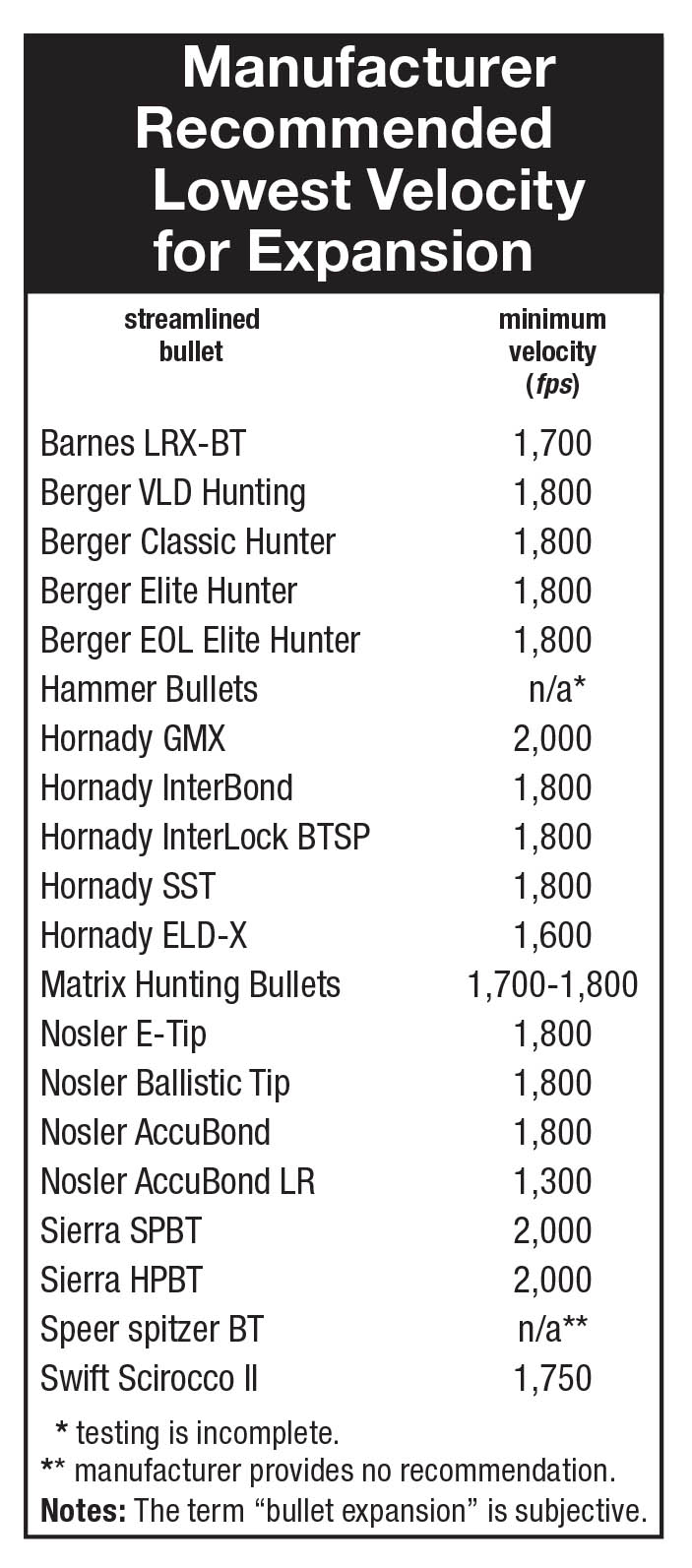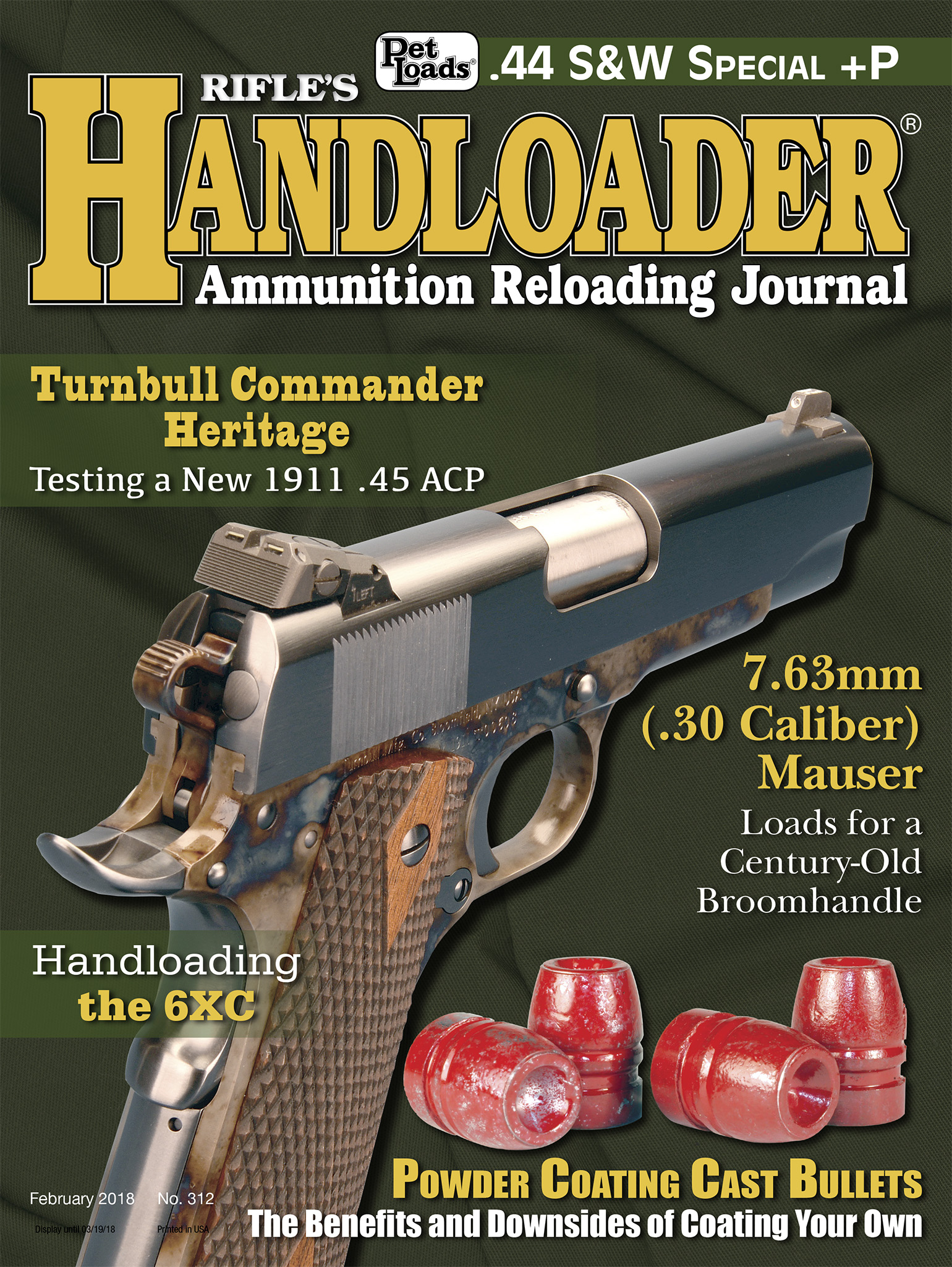
These .277-inch diameter 130-grain bullets were recovered from wet newspapers (left to right): (1) Barnes 129-grain LRX BT with a velocity of 1,565 fps just prior to impact, 16-inch penetration; (2) Berger 130 VLD Hunting, 1,542 fps, 17 inches; (3) Swift 130 Scirocco II, 1,548 fps, 15 inches; (4) Hornady 130 SST, 1,513, 9 inches; (5) Nosler 130 Ballistic Tip, 1,538, 11 inches; (6) Hornady 130 InterBond, 1,513, 15 inches; (7) Hammer 126, 1,573, 15 inches.
Developing a load for hunting is much more involved than for target shooting because a hunter not only needs to hit a specific point, he also needs effective terminal performance. When I got interested in long-range shooting, I wanted a 1,000-yard deer rifle, and I wanted to develop a load that would have the downrange performance to fulfill that desire. Only shooting later determined if I could also develop my shooting skills to equal the task. The .270 Winchester Short Magnum (WSM) was my cartridge choice.
The round carries my preferred 750 foot-pounds (ft-lbs) minimum energy figure to 1,000 yards with a number of loads and bullet weights, and with an optimized load it carries in excess of 1,000 ft-lbs to that distance.
For example, the latest Nosler manual indicates a top muzzle velocity (MV) with a 150-grain bullet in a 24-inch barrel of 3,187 fps. Nosler lists its 150-grain AccuBond LR bullet with a .625 ballistic coefficient (BC). At just 3,100 fps MV this translates to 1,111 ft-lbs of energy delivered at 1,000 yards. In other words, the .270 WSM offers the performance standards I desire without any more recoil, blast or bore wear than necessary. Bore wear is a factor because in order to place bullets precisely at long range, a shooter needs to practice a lot.
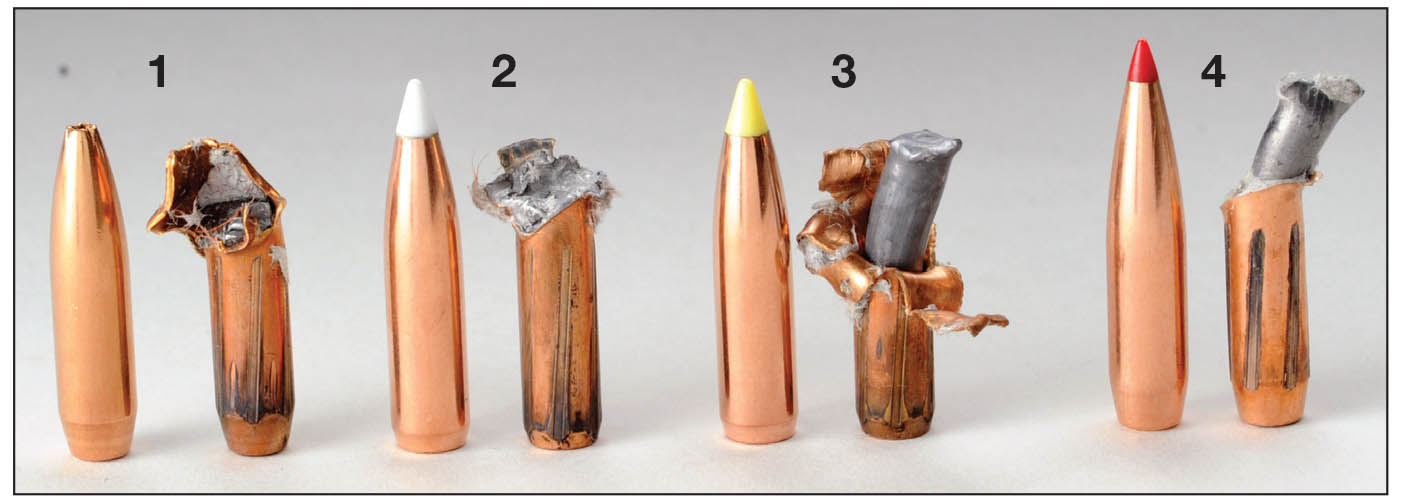
Typical examples of .277-inch diameter bullets recovered from wet newsprint include (left to right): a (1) Sierra 140-grain HPBT, 1,492 fps, 13 inches of penetration; (2) Nosler 140 AccuBond, 1,521 fps, 14 inches; (3) Nosler 140 Ballistic Tip, 1,457, 10 inches and the (4) Hornady 145 ELD-X, 1,513, 14 inches.
A thousand yards is a very long way, and a more practical distance might be 500 or 600 yards, where a less potent round is adequate. Table II in the last issue of Hand-loader No. 311 (Dec/Jan 2017) shows the distances at which several cartridges are capable. In any case, consider the terminal velocity at the longest range for which you want to prepare. Will a chosen bullet expand at this velocity? If you have hunted much you likely have seen the result of a high-velocity, pointed bullet that does not expand. It punches through with relatively little energy transfer and tissue damage. Bullet manufacturer recommendations can be consulted to determine the minimum impact velocity at which a given bullet bullet expands.
An even better choice is to check bullets yourself, using an expansion medium. I have used different mediums but find that water-soaked newspapers are the most convenient and work well. I bundle newspapers into stacks about 5 inches high with strong twine then submerge them in water overnight in a small livestock tank in the back of my pickup. The next day I go to the range, pull the soaking wet bundles out and shoot into them.
In my search for a bullet that performs well at distance, about 1,450 to 1,550 fps was targeted as a minimum velocity for expansion. Bullet manufacturers indicate that most bullets do not expand at a velocity this low, but I have found a few bullets that do expand somewhat. I used this low velocity because some of the .270 WSM loads approach this level at 1,000 yards. My thinking is that if bullets expand at the maximum intended distance, they will certainly expand at shorter ranges where impact velocity is higher, where hunting bullets are designed to perform.

Typical .277-inch diameter 150-grain bullets recovered from wet newspaper include (left to right): the (1) Matrix RBT Bonded, 1,458 fps, 15 inches of penetration; (2) Berger VLD Hunting, 1,488 fps, 15 inches; (3) Nosler AccuBond LR, 1,478 fps, 12 inches; (4) Hornady InterBond 1,512 fps, 21 inches; (5) Nosler Ballistic Tip 1,496 fps, 11 inches; (6) Sierra spitzer BT, 1,462 fps, 19 inches.
Accurate MP-5744 propellant is used for reduced-velocity loads from my .270 WSM with 130-, 140- and 150-grain bullets, with powder charges that approximate the intended terminal velocity. Yes, there is a lot of air space in the case. After chambering a test round, I hold the rifle’s muz-zle up and then carefully lower it for each shot. Bullets can be easily recovered from the newspapers. Results can be seen and penetration can be measured.
I learned several important points from this low-velocity shooting (testing only .277-diameter bullets fired from a 1:10-twist barrel):
1. Adequate penetration is not an issue.
2. Forget the usual notion of classic mushrooming.
3. In general a bullet needs something to initiate expansion, such as a plastic tip.
4. Streamlined hollowpoint bullets designed for high velocity usually do not expand.
5. Nonbonded bullets usually spew lead cores, though the core is normally recovered along with the bullet, often still partway in the jacket.
6. Most bullets tumble after impact.
7. I am not sure how important expansion is at this low velocity, because tumbling bullets can produce significant damage.
Once you have a load with a high-BC bullet loaded to a high MV that shoots accurately, the next step is to determine the load’s useful BC when fired from your rifle. Ballistic coefficient, like muzzle velocity, is not cut in stone. Load manuals report muzzle velocity, but there is no way to really know what the velocity is from your rifle until you chronograph it. The same with BC; a handloader can make predictions based on form factor or a published BC, but you do not really know a specific bullet’s trajectory curve until you shoot it.
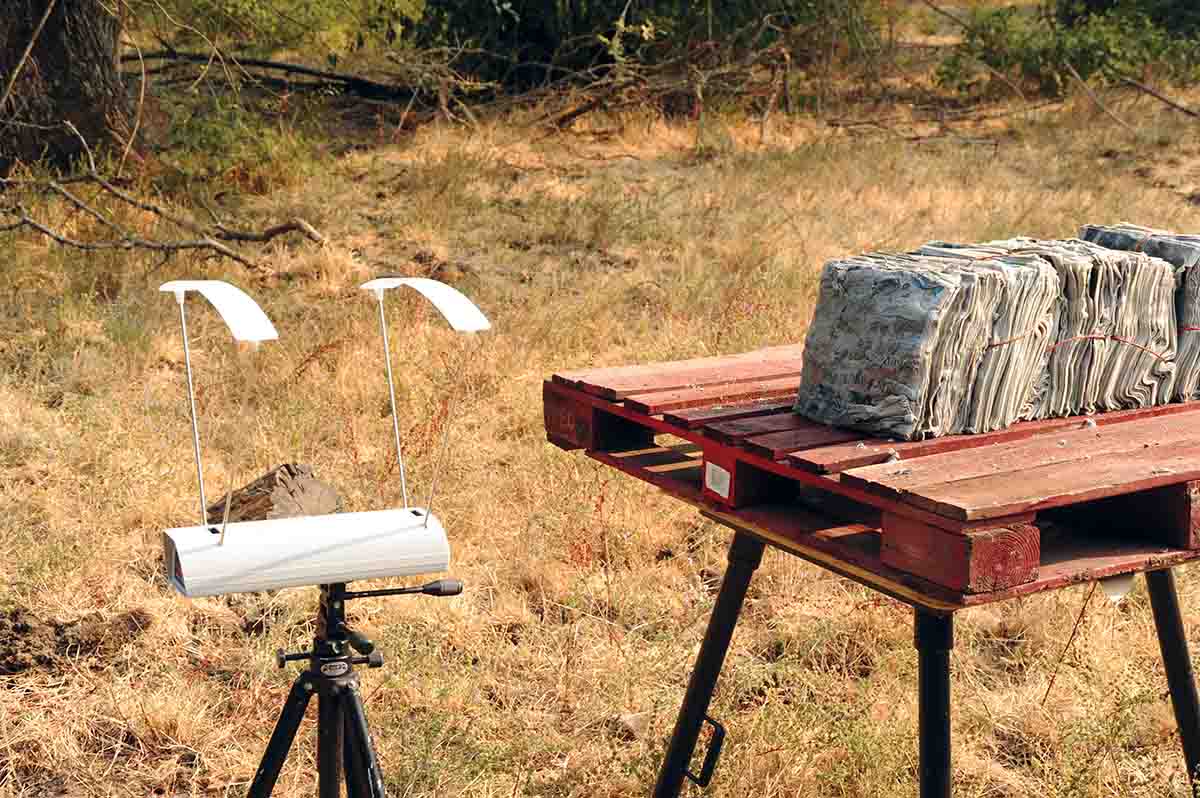
A chronograph is placed in front of wet newspapers to record velocity just prior to bullet impact.
There are a number of ways to determine real-world BC, but I use a method that allows me to practice at the same time. First I carefully zero the rifle dead-on at 100 yards with a chosen load. Then when shooting conditions are good, with little or no wind, groups are shot in 100-yard increments all the way out to 1,000 yards. (Choose your own maximum intended distance.) Using a zero or center-of-target hold each time, I record the number of scope clicks, inches or minutes of angle required to zero the rifle at each distance. I record both the vertical and horizontal adjustments necessary, because at long range there is lateral drift
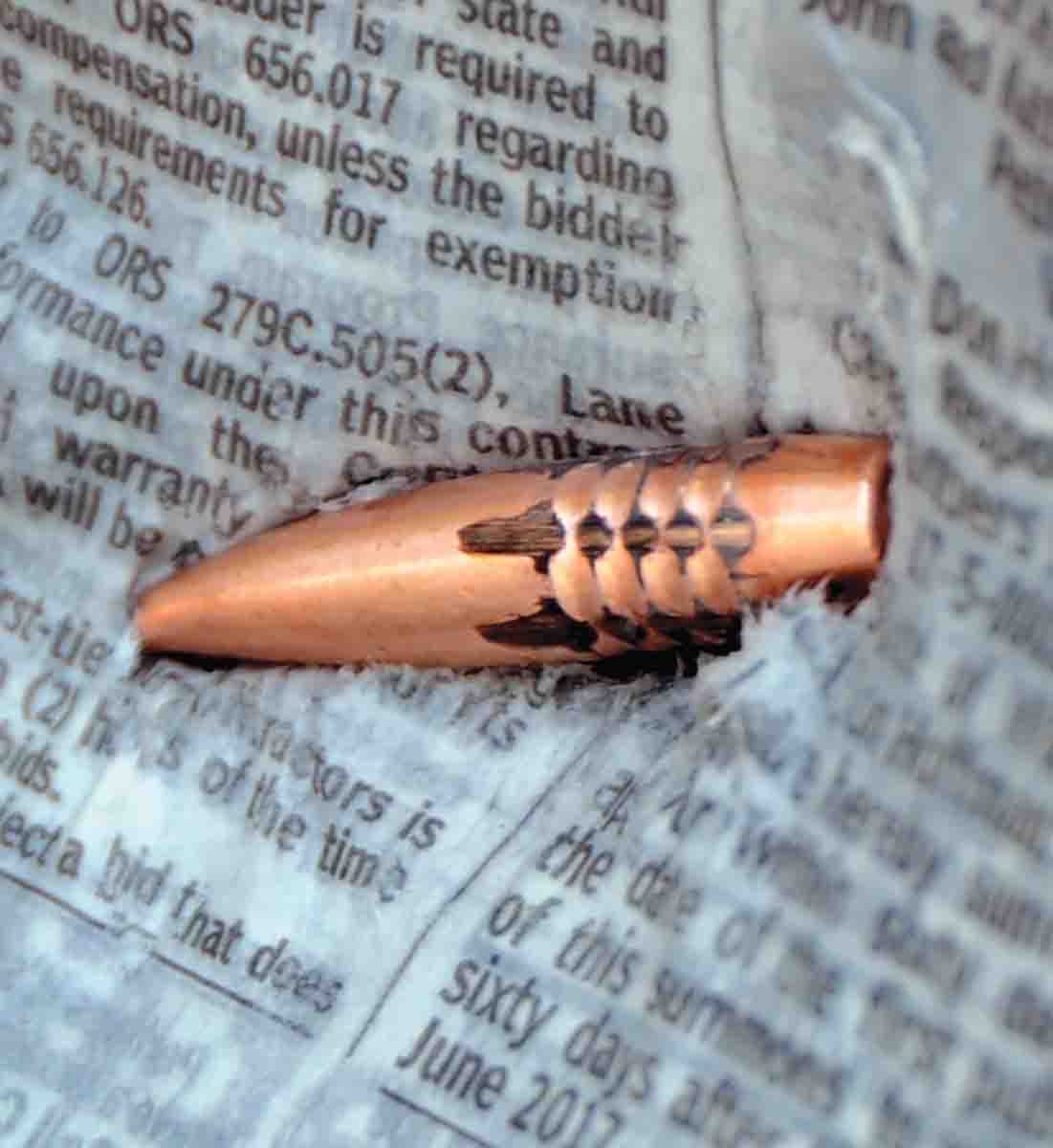
It is common for bullets to tumble at low velocity, and they are sometimes recovered sideways to the line of bullet travel.
even with no wind deflection. The vertical results of this shooting provide points on the bullet’s trajectory curve. Also recorded are the ambient conditions. Then, using a table, smartphone app, computer program or programmable rangefinder that will later be referenced in the field, I enter the known chronographed muzzle velocity and experiment by adjusting the unknown BC (usually downward) until the computer results match the actual shooting measurements. This provides an actual ballistic coefficient that is used to determine sight adjustment for any distance out to the maximum distance. It is also used to determine downrange velocity and energy much more accurately. I experiment using both the G1 and G7 drag functions to see which one best matches the actual shooting results, and go with it.
Using a Laser Technology TruPulse G7 programmable rangefinder, enter the muzzle velocity and the actual BC under the current ambient conditions. The rangefinder automatically incorporates the distance, temperature, barometric pressure and shot angle – everything needed to make a precise elevation adjustment even under changing ambient and altitude conditions. A rifleman still has to deal with lateral adjustments for wind deflection, spin drift, etc., but they are small compared to drop. The rangefinder not only displays distance, it displays the scope adjustment necessary. This rangefinder is key to my long-range shooting precision and success.
Once you have your load’s trajectory matching your rangefinder or table data, you can use it to practice, practice, practice.





